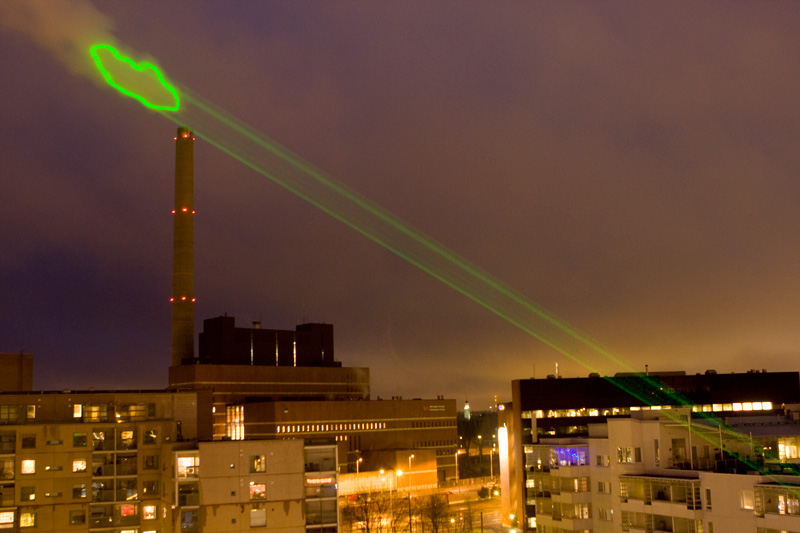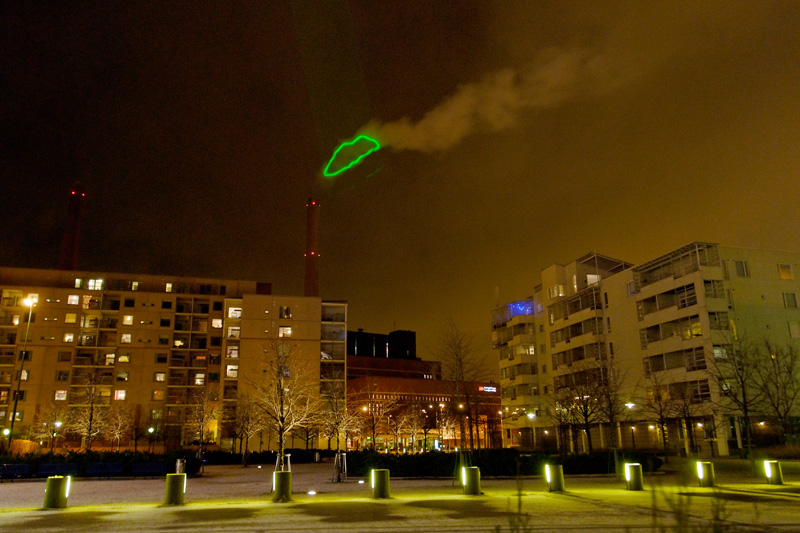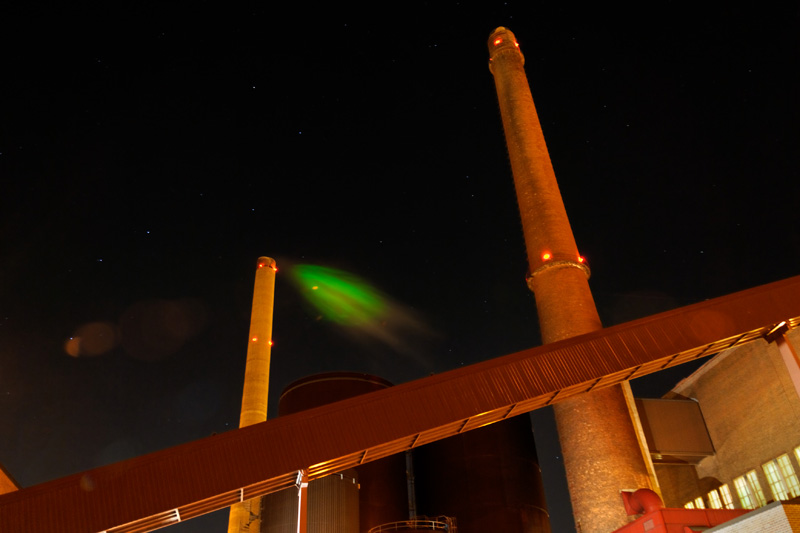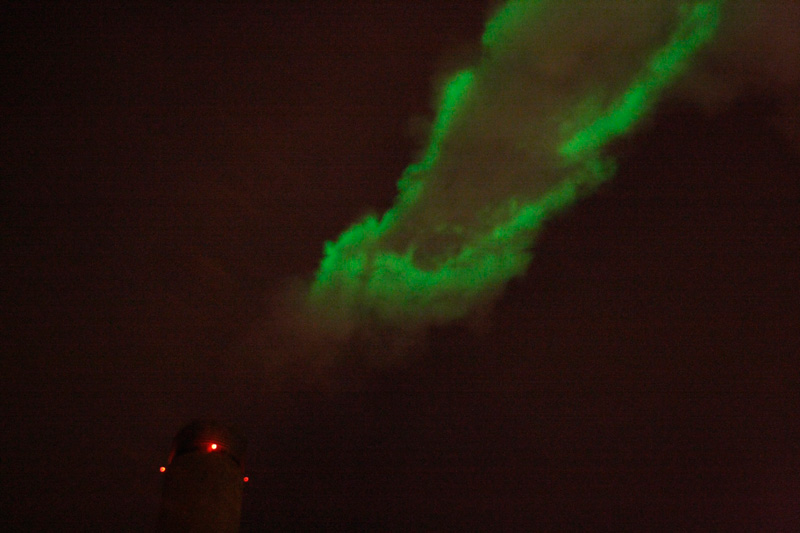NUAGE VERT
Written by Helen Evans
Published in Cluster Magasine / issue 07 Transmitting Architecture /
Torino / May 2008
Traduction en francais
The Concept of Nuage Vert
In the past decade new buzz words have entered into media discourse and everyday language: ecological visualisations, carbon offsets, eco footprints, food miles etc. These abstractions signify our attempts to quantify individual responsibility and to find ways of facing up to the very real challenges of climate change, and the exploitation of finite natural resources.
Nuage Vert is based on the idea that public forms can embody an ecological project, materialising environmental issues so that they become a subject within our collective daily lives. Its material, collective and aesthetic dimension distinguishes it from other approaches. A city scale light installation onto the ultimate icon of industrial pollution, alerts the public, generates discussion and can persuade people to change patterns of consumption.
Nuage Vert is ambiguous, as it doesn’t offer a simple moralistic message, but rather tries to confront the city dweller with an evocative and aesthetic spectacle, which is open to interpretation and challenges ordinary perception. Turning a factory emission cloud green, inevitably, leads to questions being asked. It shifts the discourse about climate change and carbon emissions from abstract immaterial models based on the individual, to the tangible reality of urban life. The project was situated in the cultural context and specific locality of Ruoholahti, a former industrial harbour redeveloped as modern residential district of Helsinki, Finland, where there is ever-increasing energy consumption.
Every night from 22-29 February 2008, the vapour emissions from the Salmisaari coal burning power plant were illuminated with a high power green laser animation. The laser drew an outline of the moving cloud onto the cloud itself, colouring it green, turning it into a city scale neon sign, which grows bigger as local residents take control and consume less electricity.
The project was conceived in 2003, whilst living in the suburbs of Paris, Saint-Ouen, looking out of the window onto a wonderfully dystopian view of a waste incinerator. The vapour emissions from this chimney were an incredible sight in the urban skyline, producing huge rolling cumulus clouds night and day, which needed highlighting. One night, while speculating on ways to colour it and dreaming up strategies for achieving this end, the wind changed direction and the cloud headed in the direction of home. This terrifying change led to an investigation about the more utilitarian function of the ‘cloud factory’, and the sociological dimension of the project began to unfold.
Stategic problems of the realisation of Nuage Vert
From the outset, it was important to work with the owners and managers of the chosen power plant and to engage them in the project, since without their cooperation the event would be a symbolic act rather than a social process. The managers were implicated, not because they own the cloud - as the cloud belongs to us all - but because the project required access to their production data, or rather, to the vital information about how much energy local residents were consuming. The actions and involvement of local residents living close to the active power plant were essential to the project, as if there was an umbilical connection between the local actions and the vapour.
After several failed attempts to realise the project in France, efforts were diverted to the Salmisaari CHP (Combined Heat and Power) power plant in Helsinki. The environmental director of Helsinki Energy, rejected the project outright, but was at least open enough to meet. After a long 4-hour debate, he began to warm to the project and personally declared his support. It took another 3 years of discussions and partner building to get the official support of Helsinki Energy, which was achieved just four months before the launch, even though major preparations had already begun. The critical mass of partners, including environmental activists and a governmental think tank, was important enough to persuade the energy company that it had become politically favourable for them to embrace the project, rather than leave it to happen without them.
To realise a project on such a scale, it was necessary to collaborate with a wide range of organisations from sectors that wouldn’t normally work together: from culture, science, industry, communication and ecology. The technical aspects were realised with the help of scientists from the Laser physics department at Helsinki Technical University and the Computer science department at the University of Illinois, as well as a medical laser manufacturer, and the energy producer itself. To mediate the project, a communication strategy was devised that employed a naïve and iconic language designed by Devalence, a Parisian design group. Working with cultural management students, slogans were created for the flyers and posters, such as: “Aurora borealis in Helsinki?”. With Dodo, an Finnish environmental activist group, Nuage Vert was presented to 240 local school children, between the ages of 7 -16. Local community groups distributed posters and flyers around the area and a sticker for switches & plugs asking people to Unplug! was distributed to 4,000 households. The project was covered by all the local freesheets, the citywide press, national radio and regional TV news. Although the communication strategy focused on activating Ruoholahti residents, the greening of the cloud was visible beyond the boundary of the city, over 10 km away.
Outcome
During the unplug event, on Friday 29th February between 7-8pm, 4,000 local residents reduced their energy consumption by 800 kVA. This is equivalent of the power generated by one windmill running for one hour.
This is the first time that an invisible digital infrastructure measuring local electricity consumption had been made public and visible. Incredibly, despite the current energy crisis and the ever-increasing demand for energy, electricity just flows freely, like a wild river, only monitored on an individual basis. The results of the unplug event - realised on a tiny budget and with limited resources – points to the future possibilities for urban planners to make complex calculations and networked information available as public forms. Giving form to the relationships between institutions and those that consume their services could lead to the creation of a new type of citizenship and the transformation of a city.
Since vast amounts of energy cannot be stored, producers across large geographical regions have to produce exactly the amount of energy that is being consumed right now, within microseconds. In Finland, the energy grid is connected to Norway, Sweden and Denmark, which means that if people in Ruoholahti consume less, even though there will be no less coal burned at the Salmisaari power plant, there will be less coal burned somewhere within the Nordic Pool. The more energy that is consumed, the higher the energy prices rise, and the more profitable it becomes to produce via expensive and unsustainable methods: such as coal-fired condensing power plants, condensing oil and gas turbines. So, the cheapest and most environmentally friendly energy is energy that is NOT consumed.
Of course, there is an element of fiction, in asking people to give up energy to feed Nuage Vert, as if the energy saved is then transferred onto the cloud. And the idea of reading information into a dynamic moving cloud requires a temporary suspension of disbelief.
As a transmitting architecture, Nuage Vert conveys multiple ideas: could this green cloud be a toxic cloud or an emblem for the collective effort of the local community? The meaning is left open for each and all to decide, and will depend upon the level of engagement.
www.nuagevert.org

Photo by Antti Aahonen

Photo by Niklas Sjöblom

Photo by Niklas Sjöblom

Photo by Antti Aahonen
version francais
Nuage Vert
Tous les soirs du 22 au 29 février 2008, le nuage de vapeur s’élevant de la centrale électrique de Salmisaari fut illuminé à l’aide d’un puissant laser de couleur verte. Une image laser était projetée sur le contour fluctuant du nuage de vapeur, réagissant à des données en temps-réel fournies par la centrale. Le nuage ainsi coloré en vert, devenait un néon à l’échelle de la ville, grandissant à mesure que les résidents du quartier de Ruohalahti se l’appropriaient et diminuaient leur consommation d’électricité.
L’histoire de Ruoholahti est celle d’un ancien port industriel transformé en une zone résidentielle moderne, où la consommation d’énergie n’en finit pas de franchir de nouveaux records.
L’installation lumineuse était visible dans le ciel d’Helsinki plusieurs kilomètres à la ronde. Vu dans l’axe du rayon laser, le contour du nuage vert apparaissait très net, projetant une image 2-d sur la surface du nuage de vapeur. Vu à 50 mètres de l’axe du rayon, le contour se fondait avec la forme tri-dimensionnelle du nuage, devenant plus flou et plus sculptural.
Le concept de Nuage Vert
Nuage vert est fondé sur l’idée que des formes publiques peuvent incarner un projet écologique et matérialiser des questions environmentales, afin de les rendre tangibles dans nos vies quotidiennes au sein de la collectivité. Ses dimensions matérielles, collectives et esthétiques, le distingue d’autres approches. Le projet déplace en effet le discours sur le changement climatique et les émissions de carbone, de modèles immatériels et abstraits calés sur l’individu vers la réalité tangible de la vie urbaine. Une installation lumineuse à l’échelle de la ville utilisant comme support l’icône même de la pollution industrielle, a le pouvoir de mettre le public en alerte, de génèrer un débat et de convaincre les gens de changer leurs habitudes de consommation.
Un processus collaboratif
Il est très vite apparu crucial de poser les bases d’une collaboration avec les propriétaires et managers de la centrale électrique et de les convaincre de s’engager dans la réalisation du projet. Sans leur coopération Nuage Vert aurait en effet été un acte symbolique plus qu’un processus social. Ils furent impliqués, non parce qu’ils détenaient des droits sur le nuage - puisque le nuage nous appartient à tous, mais parce que le projet nécessitait l’accès à leurs données de production, ou plutôt, à des informations vitales concernant la consommation des habitants du quartier. Les actions et la participation des résidents de Ruoholahti vivant à proximité de la centrale étaient quant à elles essentielles au projet, un peu comme s’il existait une relation ombilicale entre les actions locales et le nuage de vapeur.
Il aura fallu trois ans de discussion et de patient développement du partenariat avant d’obtenir le soutien officiel d’Helsinki Energy, finalement acquis quatre mois avant le lancement du projet.
Un projet de cette échelle n’aurait pu être réalisé sans l’appui d’un vaste réseaux d’individus et d’organisations, par ailleurs issus de mondes n’ayant pas l’habitude de collaborer. Nuage vert a ainsi associé des acteurs du secteur culturel, scientifique, de l’industrie, de la communication et de l’écologie.
Le projet fut réalisé en collaboration avec Pixelache, Festival of Electronic Art and Subcultures, Helsinki City Cultural Office, Helsinki Energy, DICREAM, Yrkeshögskolan Sydväst, Centre culturel français d’Helsinki, Dodo ry, HIAP – Helsinki International Artist-in-residence Programme, Foundation for Environmental Art, Nordic Cultural Point, Motiva oy, Finnish Museum of Photography, Cable Factory.
Communication
La stratégie de communication mise en place a reposé sur un language naïf et iconique conçu par Devalence, un collectif de graphistes parisien. Avec la complicité d’étudiants en management culturel, des slogans furent inventés pour les outils de communication, comme par exemple : « L’aurore boréale de Ruoholahti ? », figurant sur le flyer de Nuage Vert. Grâce au travail de Dodo, une organisation d’activistes environmentaux, Nuage Vert fut présenté à 240 élèves de primaire et de collège. Les posters et flyers furent disséminés tout autour de Ruoholahti et un auto-collant appelant les gens à ‘débrancher’ fut distribué aux 4000 foyers du quartier.
Un site internet bilingue anglais-finnois a été crée spécialement pour Nuage Vert (www.nuagevert.org). Il est une source d’information très importante et contient des documents sous forme de textes, d’images et de vidéos sur le processus de fabrication du projet. Des informations supplémentaires concernant des problématiques environmentales en lien direct avec Nuage vert seront ajoutées au site à l’automne 2008. En parallèle, une carte postale souvenir invitant les gens à retourner vers le site de Nuage vert sera produite et distribuée aux foyers de Ruoholahti.
Le projet a de plus été très bien relayé par la presse locale, la radio et les journaux télévisés régionaux. Bien que la stratégie de communication fut ciblée sur le quartier de Ruoholahti avec l’objectif d’en activer ses habitants, Nuage Vert était visible bien au-delà des limites de la ville.
Résultats
Pendant le dernier soir, de 19h à 20h, les résidents du quartier étaient invités à débrancher leurs maisons de la centrale et à venir regarder le nuage vert s’aggrandir sur la place située en face de cette dernière. Durant cette heure, 800MVA d’énergie furent économisés, ce qui équivaut à l’énergie produite par une éolienne pendant 60 minutes. Il s’agit là d’une réduction très sensible si l’on tient compte du fait que Nuage Vert ne communiqua directement qu’avec 4000 foyers, alors même que la station de Salmisaari de la quelle provenaient les données en temps-réel, fournit aussi l’énergie de 8000 foyers dans le quartier voisin de Lauttasaari. Le niveau de consommation local d’énergie était visible en direct sur le blog de Nuage Vert.
C’est la première fois que de l’information locale concernant la consommation d’énergie était rendue publique. Les résultats de cette opération mettent en exergue des scénarios futurs possibles pour les urbanistes, permettant de rendre accessibles sous des formes publiques, des calculs complexes et de l’information en réseau. Matérialiser la relation entre les institutions et ceux qui consomment leurs services pourrait mener à l’émergence d’un nouveau type de citoyenneté et de transformation des villes.
Le message de Nuage Vert, en tant qu’architecture émettrice, est multiple : ce nuage vert est-il toxique ou bien est-il l’emblème de l’effort collectif d’une communauté locale ? Le sens à donner reste ouvert et dépendra du niveau d’engagement de chacun, libre à nous d’interprèter ce message.